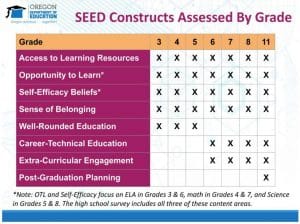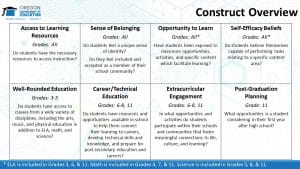Centering Student Voice in Statewide Assessment of Student Success Factors: Oregon’s SEED Survey
CompetencyWorks Blog
Competency-based education emphasizes the need to amplify student voices and develop a more balanced system of assessments to improve outcomes and equity. The Oregon Department of Education (ODE) developed a survey that has the potential to make valuable contributions in these areas and to inform similar efforts in other states. Realizing that they had never systematically asked students how they feel about their educational experiences, ODE created the survey to center student voice in state and local quality improvement efforts. Students, educators, and community members gave feedback on the survey development through discussion, community engagement meetings, and a “fairness and sensitivity review.”
The Student Educational Equity Development (SEED) survey has been administered in grades 3–8 and 11 and next year will add grades 9 and 10. It measures student perceptions of constructs that affect their outcomes but are not adequately reflected in state assessment systems. Four core constructs—access to learning resources, opportunity to learn, self-efficacy beliefs, and sense of belonging—are measured in all survey years. Additional constructs assessed in some years include extracurricular engagement, well-rounded education, career-technical education, and post-graduation planning.

At the recent Assessment for Learning Conference, three ODE staff who led development of the SEED survey—Dan Farley (Director of Assessment), Noelle Gorbett (Assessment Specialist) and Josh Rew (Psychometrician)—discussed how and why it was developed and how it is intended to support a more equitable, balanced, and actionable system of assessments in Oregon.
ODE knew that the state and districts weren’t collecting key information about what makes a school effective, and they needed more information to interpret state assessments and guide improvement efforts. For example, if state assessments show different outcomes across classrooms or schools with similar student populations, does SEED show differences in access to learning resources or opportunity to learn? Do students with better outcomes have stronger sense of belonging or extracurricular engagement? If so, the SEED findings can be a valuable tool for identifying and amplifying strong practices and policies. As a data source that is open to the public, it can also inform advocacy efforts by families and communities.
ODE explained that all of the SEED constructs have a positive, predictive relationship with student outcomes including academic achievement, graduation rates, and attendance. Some constructs were selected based on their frequent inclusion in well-developed national and international assessments such as the National Assessment of Educational Progress (NAEP), Trends in International Mathematics and Science Study (TIMSS), Program for International Student Assessment (PISA), and Progress in International Reading Literacy Study (PIRLS). Other constructs, such as sense of belonging, were added based on feedback about their importance from school and community partners. Constructs that were already captured by other state data collection activities were not included in the SEED survey. Definitions of the survey constructs are shown in the image below.

Two of the constructs—opportunity to learn and self-efficacy beliefs—focus on specific content areas in each grade (reading in 3rd & 6th, math in 4th & 7th, and science in 5th & 8th ). The high school version includes all three content areas, and grades 3-5 also have items about music, art, and physical education. The elementary and middle school versions take about 15 minutes to complete, and the high school version takes about 30 minutes.
A key difference between Oregon’s SEED survey and existing surveys of similar constructs is that findings will be transparent and available to the public, rather than released at local discretion. ODE believes this will make the survey a powerful advocacy and quality improvement tool for districts that opt to participate. Over time, ODE hopes to incorporate the findings into district and state “report cards” to help stakeholders interpret assessment data and identify inputs and practices that can improve student outcomes. The findings will be reported by race/ethnicity, IEP status, and free and reduced price lunch status subgroups, which is important for efforts to improve equity.
Participants in the 2020-21 school year pilot survey included 64 out of 197 districts (32.5%) and about 13,600 of the 400,000 students (3.4%) in the grades targeted by the survey. Given these numbers, ODE recognizes that the sample was likely not representative and they plan to do additional piloting and development. They also plan to meet with school and district leaders this summer to develop a community of practice around what questions they should be asking, what issues to discuss, and how to use the findings most effectively.
ODE has made extensive information available on the SEED Survey landing page, including a statement of purpose, an overview slide deck, all of the survey items in English and Spanish, and materials for communicating about the survey with families and staff. While reviewing the survey items, I was impressed with the many valuable insights that could emerge to inform practice and policy. Two questions I had were whether some of the language was too complex for students in certain grade levels, and how ODE concluded that various sets of items provided valid measures of the survey’s core constructs. To address these and other questions that might arise as districts are deciding whether to adopt the survey, it would be helpful if ODE shared more about their survey development and validation work.
By embarking on this ambitious effort to create statewide assessments of key educational constructs that are too often ignored, the Oregon Department of Education is amplifying students’ voices and increasing the capacity of schools, districts, families, and policymakers to improve student outcomes and educational equity. By inviting others to adopt or adapt the surveys for local purposes, they are leveraging their work to have an impact beyond Oregon.
Learn More
- How Systems of Assessments Aligned with Competency-Based Education Can Support Equity
- Future Focused State Policy Actions to Transform K-12 Education
- Competency-Based Education Needs Deeper Evaluation of Educational Equity Outcomes
Eliot Levine is the Aurora Institute’s Research Director and leads CompetencyWorks.